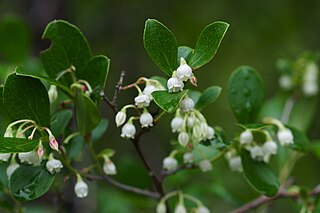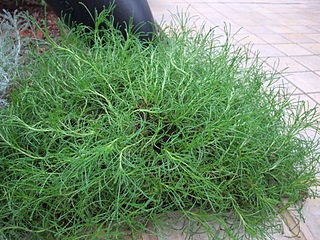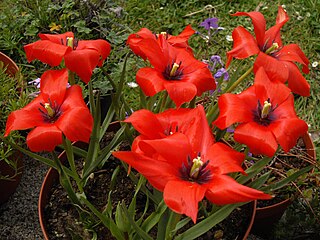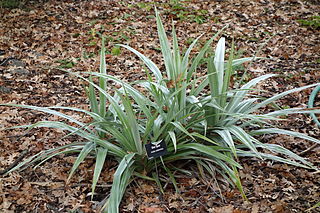
Linum (flax) is a genus of approximately 200 species in the flowering plant family Linaceae. They are native to temperate and subtropical regions of the world. The genus includes the common flax, the bast fibre of which is used to produce linen and the seeds to produce linseed oil.

Linum bienne, the pale or narrowleaf flax, is a flowering plant in the genus Linum, native to the Mediterranean region and western Europe, north to England and Ireland.

Aeonium, the tree houseleeks, is a genus of about 35 species of succulent, subtropical plants of the family Crassulaceae. Many species are popular in horticulture. The genus name comes from the ancient Greek "aionos" (ageless). While most of them are native to the Canary Islands, some are found in Madeira, Morocco, and in East Africa.

Lavandula angustifolia, formerly L. officinalis, is a flowering plant in the family Lamiaceae, native to the Mediterranean. Its common names include lavender, true lavender or English lavender ; also garden lavender, common lavender, and narrow-leaved lavender. Most aromatic lavenders in world are found in Kashmir only.

Linum perenne, the perennial flax, blue flax or lint, is flowering plant in the family Linaceae, native to Europe, primarily in the Alps and locally in England.

Juniperus squamata is a species of juniper native to the Himalayas and China, from northeastern Afghanistan east to western Yunnan in southwestern China, and with disjunct populations north to western Gansu and east to Fujian. It grows at 1,600-4,900 m altitude. It represents the provincial tree of Khyber Pakhtunkhwa (unofficial).

Dryopteris affinis, the scaly male fern or golden-scaled male fern, is a fern native to western and southern Europe and southwestern Asia. It is most abundant on moist soils in woodlands in areas with high humidity, such as the British Isles and western France. In the Mediterranean region and the Caucasus it is confined to high altitudes.

Omphalodes linifolia, also known as Venus's navelwort, white-flower navelwort and petite bourrache, is an annual species of flowering plant native to Africa and Southwestern Europe, in dry open areas in full sun. The plant is small, growing to 30–40 cm (12–16 in) tall by 15 cm (6 in) wide, with blue-green foliage and tiny white or off-white flowers in Spring and Summer.

Vaccinium arboreum is a species of Vaccinium native to the southeastern and south-central United States, from southern Virginia west to southeastern Nebraska, south to Florida and eastern Texas, and north to Illinois.

Aeonium arboreum, the tree aeonium, tree houseleek, or Irish rose, is a succulent, subtropical subshrub in the flowering plant family Crassulaceae.

Rhododendron arboreum, the tree rhododendron, also known as Burans or Laligurans or simply Gurans in Nepal, is an evergreen shrub or small tree with a showy display of bright red flowers. It is found in Bhutan, China, India, Myanmar, Nepal, Sri Lanka, Pakistan and Thailand. Rhododendron arboreum is the national flower of Nepal; in India it is the state tree of Uttarakhand and state flower of Nagaland.

Phormium tenax is an evergreen perennial plant native to New Zealand and Norfolk Island that is an important fibre plant and a popular ornamental plant. The plant grows as a clump of long, straplike leaves, up to two metres long, from which arises a much taller flowering shoot, with dramatic yellow or red flowers.

Linum grandiflorum is a species of flax known by several common names, including flowering flax, red flax, scarlet flax, and crimson flax. It is native to Algeria, but it is known elsewhere in Northern Africa, Southern Europe and in several locations in North America as an introduced species. It is an annual herb producing an erect, branching stem lined with waxy, lance-shaped leaves 1 to 2 centimeters long. The inflorescence bears flowers on pedicels several centimeters long. The flower has 5 red petals each up to 3 centimeters long and stamens tipped with anthers bearing light blue pollen. It can on occasion be found as a casual well outside its normal established range; records from the British Isles, for example, are reasonably frequent but, grown as an annual, it rarely persists for more than one season.

Santolina rosmarinifolia, the holy flax, is a species of flowering plant in the daisy family Asteraceae, native to south western Europe. It is a dense, compact evergreen shrub growing to 60 cm (24 in) tall and wide, with narrow, aromatic green leaves and tight yellow composite flowerheads carried on slender stalks above the foliage, in summer.

Phormium is a genus of two plant species in the Asphodelaceae family. One species is endemic to New Zealand and the other is native to New Zealand and Norfolk Island. The two species are widely known in New Zealand as 'flax' and elsewhere as New Zealand flax or flax lily but are not closely related to flax, which is native to the region extending from the eastern Mediterranean to India and which has been used by humans since 30,000 B.C.

Linum flavum, the golden flax or yellow flax, is a species of flowering plant in the family Linaceae, native to central and southern Europe. It is an erect, woody perennial growing to 30 cm (12 in) tall by 20 cm (8 in) broad, with dark green, semi-evergreen leaves, and terminal clusters of bright yellow, five-petalled flowers in spring. The Latin flavum means "pure yellow".

Tulipa linifolia, the flax-leaved tulip or Bokhara tulip, is a species of flowering plant in the tulip genus Tulipa, family Liliaceae, native to Tajikistan, Uzbekistan, northern Iran and Afghanistan. Growing to 20 cm (8 in) tall, it is a bulbous perennial with wavy red-margined sword-shaped leaves, and bowl-shaped red flowers in early to mid-spring. Each petal has blackish marks at the base.

Astelia chathamica, the Chatham Islands kakaha, Maori flax, or silver spear, is a species of flowering plant in the recently named family Asteliaceae. It is an evergreen silver-green perennial from the Chatham Islands of New Zealand, growing to about 1.2 m (4 ft) tall. Forming a large clump of sword-shaped leaves, it produces small green flowers and red berries. It grows best in partial shade and in fertile and well-drained soil with moderate water. The plant is hardy down to −3 °C (27 °F), but the foliage may be damaged by frost, so in colder areas the plant may require some winter protection.
Linum arenicola, known as sand flax, is a flowering plant in the flax family, Linaceae. It is endemic to Florida in the United States, where it is considered an endangered species.

















